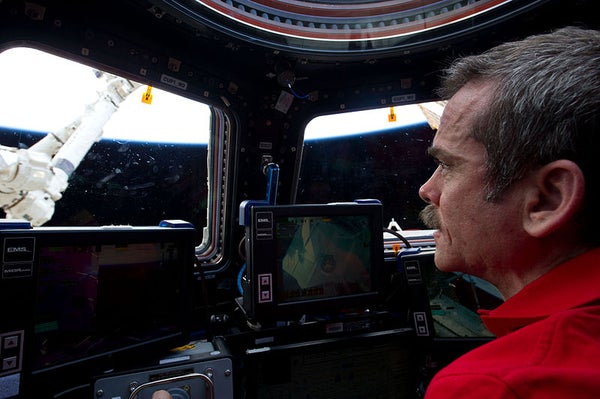This article was published in Scientific American’s former blog network and reflects the views of the author, not necessarily those of Scientific American
Yesterday, former International Space Station Commander Chris Hadfield fell from space like a meteor and gently touched down on his home planet after five months in a state of constant free fall. He was greeted with a recliner and a blanket, ready to cradle his thinner bones and atrophied muscles. Maybe, as he was comforted and challenged by gravity once again, his eyes turned back longing to the sky. I hope he knows that we did the same when he turned a camera lens into the eyes of the world.
Chris Hadfield is a triumph of science communication. He began by simply tweeting out pictures of the Earth in all its often-overlooked beauty from his Twitter account. As a consequence of these breathtaking pictures, and Hadfield’s famous response to a tweet from William Shatner, Hadfield soon became a social media phenomenon. At this writing, he has amassed 920,000 Twitter followers (up almost 150,000 from my last edit 12 hours ago!). The Canadian Space Agency quickly capitalized on Hadfield’s fame, making a series of wonderfully explanatory videos with Hadfield doing everything from shaving to simulated crying to explaining exactly how he gets those amazing pictures. Hadfield’s outreach didn’t stop there. Many of his videos were direct answers to student questions. A surprisingly good singer and guitarist, Hadfield performed the first space-earth music collaboration with the lead singer of the Bare Naked Ladies. He covered David Bowie’s classic “Space Oddity” brilliantly. And to the delight of nerds everywhere, he even had a chat with William Shatner about Star Trek.
Why has Hadfield been so successful, particularly in the social media landscape where other science rock stars like Neil deGrasse Tyson barely tread? I think it’s because he is the first star science communicator to launch into our collective orbits in this generation. Giants like Nye and Tyson and Dawkins were all in the communication game long before Hadfield first tweeted. The commander was thrust in the lime light of a buzz fed culture, took the torch passed to him by the likes of Sagan, and ran with it. He did not let the torch go out. Rather than being a blip in a Twitter feed, Hadfield continued to impress, continued to inspire, continued to communicate science where others might have faltered. Combine this able cradling of nearly the whole Internet with Hadfield’s calm, cool, delightful demeanor, and you get a role model. But Hadfield is the best kind of role model. Though he certainly inspires and educates, he is always quick to note that anyone can achieve what he has, that the cosmos is open to us. He’s a role model for role models.
On supporting science journalism
If you're enjoying this article, consider supporting our award-winning journalism by subscribing. By purchasing a subscription you are helping to ensure the future of impactful stories about the discoveries and ideas shaping our world today.
Science, as far as we know, applies to every part of the universe. You don’t have to go into space to know how objects will interact. But there is just something about being up there that makes the critical difference in human storytelling and understanding. I can tell you about space, but Hadfield showed us space in an easily accessible way. With a laptop and 140 characters, he brought us into space too. If you go by percentages, practically none of us will go into space. The commander brought me, all of us, a little closer.
Apart from being congratulated for successfully commanding the ISS (and for dealing with emergencies like the recent potential ammonia leak), Chris Hadfield is being congratulated for his communication efforts. On Twitter, where Hadfield garnered such fame, there was already a hashtag trending in his home country of Canada called #ThankYouCommanderHadfield. As so many people reach out to him, science communicators should too. They should take note of his poise, his calmness, and the genuine and pure way he answers questions.
In science communication we don’t just want the facts If that were true, a computer could have done Carl Sagan’s job. We want someone we can relate to, someone who makes sense in that situation–the right person at the right time. In science fiction, we deal with the extremes of good and evil, scoundrels and heroes, but for the most part we create this human ideal in space. Who else to explore the cosmos and possibly find new life than someone we would be proud to have represent us? In science fiction like Star Trek, Captain Picard fills this role. He is a measured man, a renaissance man, a leader who is calm and collected in tense situations but also revels in the time spent exploring new frontiers and sharing that knowledge with others. Sound familiar?
So let me say my thank you to Chris Hadfield. He took a sudden spotlight that illuminated him and pointed it a bit to the side, catching the stars behind him. He proved that effective science communication can be done in new mediums without vitriol or shameless promotion. He is a new and shining data point on the trendline that Sagan started. “You’ve really made the grade” commander.
For months Commander Hadfield was a megaphone for cosmic beauty; we all heard him, we all listened, we all watched. And we love him for it.
Image Credit:
Inside the Cupola of the International Space Station by NASA
